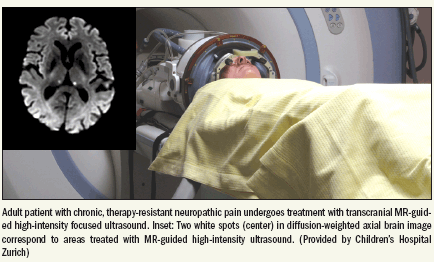- AI
- Molecular Imaging
- CT
- X-Ray
- Ultrasound
- MRI
- Facility Management
- Mammography
Zurich team tests HIFU in cranial neurosurgery
For the first time, high-intensity focused ultrasound has been applied, under MR guidance, to thermally ablate cranial lesions, at the Children’s Hospital Zurich.
The first 10 patients were treated for chronic, therapyresistant neuropathic pain. The stereotactic target for MRguided ultrasonic ablation was the centrolateral nucleus of the thalamus. All interventions, which took place since September 2008, were completed successfully and without complications, according to Beat Werner, Ph.D., deputy project leader at the hospital.
HIFU interventions are routinely performed under MR guidance at sites around the world to ablate uterine fibroids. The technology has been stretched in recent years to destroy tumors of the prostate gland and cancerous fibroadenomas of the breast. The Swiss scientists are the first to apply HIFU to neurosurgery. They are now looking to apply the modality in pediatric cases.
They plan to continue this study for 20 more patients and are preparing a new study for patients suffering from Parkinson’s disease and tremor, according to Werner
“Next, we will aim at dystonia and spasticity,” he said.
HIFU promises a number of advantages over conventional neurosurgery. It offers greater precision, as the intervention can be imaged in real-time. Because it is noninvasive, HIFU is not subject to tissue shift, which may occur during surgery due to tissue excision. And the MR-guided technique can also be performed on an outpatient basis.
Performed as part of the Swiss National Research Program NCCR Co-Me (computer-aided and image-guided medical interventions), the procedures employ a prototype system for transcranial MR-guided HIFU, an ExAblate 4000, built by InSightec and combined with a 3T GE MR scanner. A semispherical ultrasound transducer is mounted at the top of the patient table. A stereotactic frame immobilizes the patient’s head in front of the transducer.

The experimental method was tested initially on phantoms, which demonstrated that MR-guided HIFU could noninvasively and selectively ablate tissues. The clinical interventions are being done at the MR Center of the University Children’s Hospital Zurich under the direction of Dr. Daniel Jeanmonod, neurosurgeon in the functional neurosurgery department of the Neurosurgical Clinic at the University Hospital Zurich, and Professor Ernst Martin, director of the Magnetic Resonance Center at the University Children’s Hospital Zurich.
MR-guided HIFU interventions are planned and monitored in real-time. Ultrasound energy is channeled from 1024 transducers through the intact skull of the patient into the brain and concentrated into a diameter measuring 3 to 4 mm. The focal temperature of 60ºC is achieved through sequential sonifications each lasting 10 to 20 seconds. Tissue temperature is continuously displayed on precise MR-temperature distribution maps. The several-hour neurosurgical procedure is performed with patients awake and fully conscious.
The goal of the research team is to groom transcranial MR-guided HIFU as a noninvasive intervention for functional neurosurgery and the treatment of brain tumors, stroke, and various neurological brain disorders.
FDA Approves Fluorescence Imaging System for Detecting Residual Breast Cancer
April 18th 2024The combination of the optical imaging agent Lumisight and the fluorescence imaging device Lumicell Direct Visualization System, collectively known as LumiSystem, reportedly offers 84 percent accuracy with real-time detection of residual breast cancer after lumpectomy procedures.
Study of Ofatumumab for Multiple Sclerosis Shows 'Profoundly Suppressed MRI Lesion Activity'
April 17th 2024The use of continuous ofatumumab in patients within three years of a relapsing multiple sclerosis diagnosis led to substantial reductions in associated lesions on brain MRI scans, according to research recently presented at the American Academy of Neurology (AAN) conference.
Could a Deep Learning Model for Mammography Improve Prediction of DCIS and Invasive Breast Cancer?
April 15th 2024Artificial intelligence (AI) assessment of mammography images may significantly enhance the prediction of invasive breast cancer and ductal carcinoma in situ (DCIS) in women with breast cancer, according to new research presented at the Society for Breast Imaging (SBI) conference.
